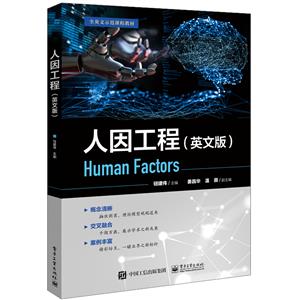-
>
决战行测5000题(言语理解与表达)
-
>
软件性能测试.分析与调优实践之路
-
>
第一行代码Android
-
>
深度学习
-
>
Unreal Engine 4蓝图完全学习教程
-
>
深入理解计算机系统-原书第3版
-
>
Word/Excel PPT 2013办公应用从入门到精通-(附赠1DVD.含语音视频教学+办公模板+PDF电子书)
人因工程(英文版 ) 版权信息
- ISBN:9787121407734
- 条形码:9787121407734 ; 978-7-121-40773-4
- 装帧:一般胶版纸
- 册数:暂无
- 重量:暂无
- 所属分类:>
人因工程(英文版 ) 本书特色
适读人群 :本书可作为高校院所工业工程、人工智能、智能制造、机械工程、安全工程等相关专业双语课与全英文示范课的本科、研究生教材,亦可作为从事汽车、航空航天、船舶、军工、机器人乃至办公室工作人员的参考书。人因工程是通过人-机-环境系统优化来达到提高系统生产率,保证人健康、安全、舒适工作的学科。本书作者集十多年从事人因工程教学科研的实践经验,根据人因工程的z新发展趋势,突出理论与实践相结合、基础与前沿相结合的原则编纂而成。
人因工程(英文版 ) 内容简介
人因工程是通过人-机-环境系统优化来达到提高系统生产率,保证人健康、安全、舒适工作的学科。本书作者集十多年从事人因工程教学科研的实践经验,根据人因工程的**发展趋势,突出理论与实践相结合、基础与前沿相结合的原则编纂而成。 本书分为4部分(基础知识、生理人因、认知人因与人因应用)共计12章,主要内容包括人与人因、人因研究常用方法、人体测量、生理机能、疲劳与肌骨失调、职业生物力学、视觉系统、听觉系统、其它感知系统、视觉显示、压力与心理负荷、人因工程日常应用等。
人因工程(英文版 ) 目录
目 录
Chapter 1 Introduction to Human Factors 1
1.1 What is Human Factors 2
1.1.1 Concept of Human Factors 2
1.1.2 Domain of Human Factors 7
1.2 Goals of Human Factors 11
1.3 History of Human Factors 14
1.3.1 The Origin and Development of Human Factors 14
1.3.2 The Development of Human Factors in China 18
1.4 Areas of Ergonomics Research and Practice 20
1.4.1 Research Content 20
1.4.2 Application Areas 24
References 26
Chapter 2 Methods in Human Factors 27
2.1 Taxonomy 28
2.2 Descriptive Method 30
2.2.1 Scenario 30
2.2.2 Variable 31
2.2.3 Subjects 31
2.2.4 Data Collection & Analysis 32
2.3 Experimental Method 35
2.3.1 Scenario 35
2.3.2 Variable 36
2.3.3 Subjects 37
2.3.4 Data Collection & Analysis 37
2.4 Evaluation Method 40
2.4.1 Scenario 40
2.4.2 Variable 41
2.4.3 Subjects 42
2.4.4 Data Collection & Analysis 42
References 46
Chapter 3 Anthropometry 47
3.1 What is Anthropometry 48
3.2 Terminology 51
3.2.1 Basic Posture 51
3.2.2 Measurement Plane 53
3.3 How Dimensions Measured, Collected & Processed 55
3.3.1 Conventional Methods 55
3.3.2 Three Dimensional (3D) Anthropometry 56
3.4 Applications 62
3.4.1 Digital Human Modeling and Simulation 62
3.4.2 Product Design for Special Population 68
3.4.3 Crowd Simulation 71
3.4.4 Virtual Try-on 73
3.5 International Anthropometric Standards 75
References 77
Chapter 4 Physiology 78
4.1 Structure of Muscles 79
4.2 Energy Production 83
4.2.1 Energy Supply 83
4.2.2 Classification of Energy Metabolism 85
4.3 Circulatory & Respiratory System 87
4.3.1 The Circulatory System 87
4.3.2 The Respiratory System 89
4.3.3 The Connection between the Respiratory System and Circulatory System 91
4.4 Energy Expenditure 93
4.5.1 Physical Work Capacity & Energy Expenditure Limits 97
4.5.2 How to Measure Energy Expenditure 97
References 101
Chapter 5 Fatigue & Musculoskeletal Disorders 102
5.1 Definition 103
5.1.1 Fatigue 103
5.1.2 Musculoskeletal Disorders 107
5.2 Types 108
5.3 Factors 111
5.3.1 Physical Factors 111
5.3.2 Organizational Factors, Psychosocial Factors and Individual Factors 113
5.4 Recovery 114
5.5 Case Study 116
References 117
Chapter 6 Occupational Biomechanics 119
6.1 Biomechanics & Occupational Biomechanics 120
6.1.1 Biomechanics 120
6.1.2 Occupational Biomechanics 122
6.2 Biomechanical Models 130
6.2.1 Introduction of Biomechanical Models 130
6.2.2 The 2D Static Strength Model 131
6.3 Low Back Biomechanics and Manual Material Handling 135
6.3.1 Low Back Biomechanics and Manual Material Handling 135
6.3.2 NIOSH Lifting Equation 137
References 144
Chapter 7 Visual System 146
7.1 Light 147
7.1.1 The Sources of the Light 147
7.1.2 Color System 148
7.1.3 The Visual Receptor System 150
7.2 Illumination 154
7.2.1 Measurement of Light 154
7.2.2 Contrast Sensitivity 155
7.3 Visual Perception 157
7.3.1 Top-down vs. Bottom-up 157
7.3.2 Depth Perception 158
7.4 Visual Search 161
7.4.1 Serial Search 161
7.4.2 Parallel Search 162
References 168
Chapter 8 Auditory System 169
8.1 Mechanics of Sound 170
8.1.1 Wave, Frequency, Amplitude and Intensity 171
8.1.2 Measuring the Intensity of Sound 172
8.2 Structure of Human Ear 174
8.2.1 The Outer Ear 174
8.2.2 The Middle Ear 175
8.2.3 The Inner Ear 175
8.3 Perception of Sound 177
8.3.1 Loudness and Pitch 177
8.3.2 Sound Source Location 178
8.3.3 Hearing Loss 180
8.4 Noise 182
8.4.1 Assessing and Controlling Noise Risks 183
8.4.2 Hearing Protection 184
8.5 Case Study 185
References 186
Chapter 9 Other Perception Channels 187
9.1 Tactile Perception 188
9.1.1 Definition of Tactile Perception 189
9.1.2 Applications of Tactile Perception 190
9.2 Vestibular Sensation 192
9.2.1 Vestibular System 192
9.2.2 Semicircular Canal System 192
9.2.3 Otolithic Organs 195
9.2.4 Equilibrioception 197
References 198
Chapter 10 Displays 200
10.1 Introduction of Displays 201
10.1.1 Concepts of Displays 201
10.1.2 The Way of Displays’ Classification 202
10.2 Display design 203
10.2.1 Principles of Display Design 203
10.2.2 Coding Schema 206
10.3 Navigation Displays 208
10.3.1 Line Table and Instruction Display 209
10.3.2 Maps 210
10.4 Adaptive Multimodal Displays 215
10.4.1 Multimodal Interaction 215
10.4.2 Adaptive Multimodal Displays 218
References 223
Chapter 11 Stress & Mental Workload 224
11.1 Concept & Possible Effects of Stress 226
11.2 Yerkes-Dodson Law 227
11.3 What is Mental Workload 229
11.4 Mental Workload Measurement 230
11.4.1 Primary-task Performance Measures 230
11.4.2 Secondary-task Performance Measures 231
11.4.3 Physiological Measures 234
11.4.4 Subjective Evaluation Measures 235
References 239
Chapter 12 Applications in Daily Life 241
12.1 Traditional Transportation 242
12.1.1 Driver Information Systems 242
12.1.2 Advanced Driver-assistance Systems 245
12.1.3 Autonomous Cars 246
12.2 E-business 249
12.3 Design for the Aged 254
12.4 Design for the Disabled 258
References 261
人因工程(英文版 ) 作者简介
钮建伟,博士,博导,2008.7-至今北京科技大学机械学院,(1)美国人因工效学会会员。(2)中国人因工效学会会员。(3)中国管理工效学会专业委员会委员。
- >
烟与镜
烟与镜
¥24.0¥48.0 - >
史学评论
史学评论
¥22.7¥42.0 - >
新文学天穹两巨星--鲁迅与胡适/红烛学术丛书(红烛学术丛书)
新文学天穹两巨星--鲁迅与胡适/红烛学术丛书(红烛学术丛书)
¥9.9¥23.0 - >
龙榆生:词曲概论/大家小书
龙榆生:词曲概论/大家小书
¥13.0¥24.0 - >
苦雨斋序跋文-周作人自编集
苦雨斋序跋文-周作人自编集
¥5.8¥16.0 - >
朝闻道
朝闻道
¥8.8¥23.8 - >
有舍有得是人生
有舍有得是人生
¥17.1¥45.0 - >
推拿
推拿
¥12.2¥32.0
-
”互联网+“时代计算机算法的应用及其实践研究
¥19.9¥59 -
微服务设计
¥52.8¥69 -
图说深度学习:用可视化方法理解复杂概念
¥109¥188 -
计算机基础
¥17.2¥31 -
改变未来的九大算法
¥50¥68 -
生成式AI入门与AWS实战
¥77.8¥99.8





















